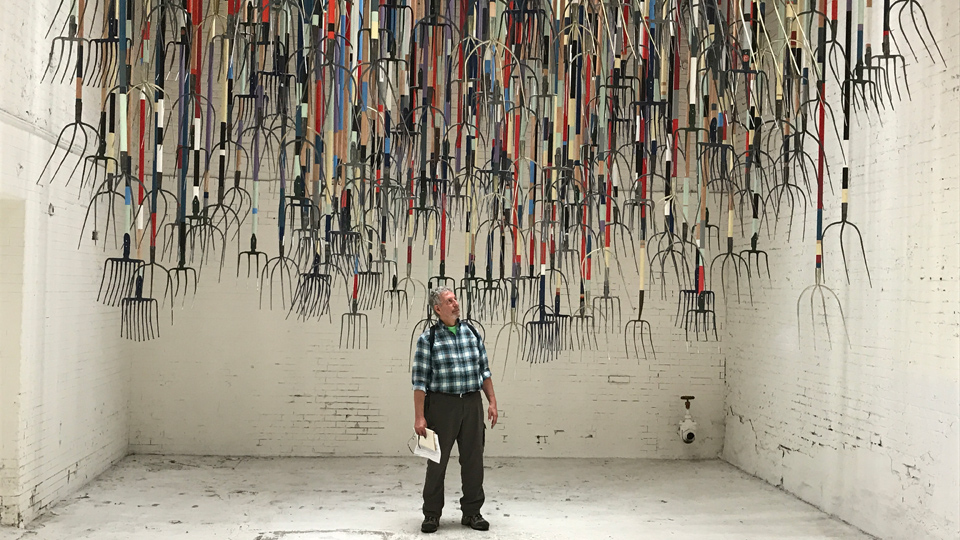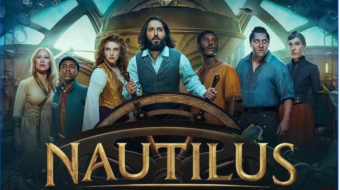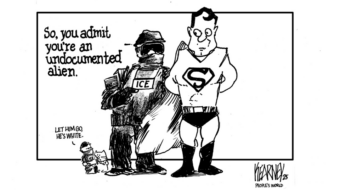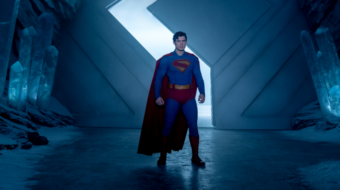
LOS ANGELES—Columnist Steve Lopez writes in the L.A. Times (May 17) about pissed-off citizens turning out for town hall meetings with their congressional representatives—even if said representatives fail to put in an appearance. “These pitchfork rallies have been happening all over the country,” he reminds his readers.
I wonder if he’s paid a visit to The 14th Factory, where he might have picked up that potent image. One of the couple of dozen art installations in this new pop-up gallery in Lincoln Heights, east of downtown, features 300 pitchforks suspended from the ceiling, each one representing a workers’ or peasants’ revolt somewhere in the world. They come in variations of anywhere from three to nine tines apiece, and their poles are painted in fourteen colors symbolizing the epoch of human history in which that rebellion took place, the length of time it lasted, and its precise latitude and longitude.
Stand under and among these pitchforks and you get a Sword of Damocles feeling, that you might at any moment become the pointed object of an aroused people’s call to arms against injustice. I don’t know if people in agrarian societies still use pitchforks as protest symbols, but every day we see the equivalent in mass demonstrations, petition campaigns, workers uniting to form unions and get paid a living wage, people running for office who never dreamed they would, and broad grassroots efforts to overthrow lousy officeholders and replace them with righteous folk.
Enter the three acres of what 14th Factory promoters are calling “the largest art experience in Los Angeles”—a questionable claim considering the size of some of our city’s museums—and you will uncover an ever-changing immersive labyrinth of 14 interlinked spaces comprised of video, installation, sculpture, paintings and performance. There is supposed to be an overarching narrative tying all these works together—“a contemporary hero’s journey”—but it’s nonspecific and if it exists it may simply come together only in the viewer’s mind.
Conceived by the Hong Kong-based British artist Simon Birch, The 14th Factory is a monumental, socially engaged art and documentary environment housed in a massive empty industrial warehouse and lot that once served as a Chinese food production and distribution center.
“This is a very emotional time for people, rife with division, anger, and frustration,” says Birch. “Many people are feeling unstable and upended with the political climate. Given the current fragile state of the world, we need unity more than ever—and we need action….
“As artists, we have a responsibility to reflect, react, engage, but above all, to not stand by the sidelines.
“The 14th Factory is an action…, a world that celebrates diversity, singularity and limitless possibility but also exposes darkness and hints at the dangers if we do nothing.
“My hope for The 14th Factory is to bring a broad range of minds together, to uplift and inspire, ignite conversation, action and solutions but also to provoke. There are installations here that discuss love, loss, fear, pain, hope—our shared experience—but that also ask the question, As civilizations have risen and fallen, are we now at the brink of collapse or the start of a wonderful new chapter?”
Collaborating artists come from China, Hong Kong, the United States, the United Kingdom and Canada. The space is divided into viewing rooms of varying dimensions connected by dark passageways. The first room contains The Meteor, a huge structure resembling a black dinosaur that you might assemble from a balsa wood kit. It was designed by Hong Kong-based KplusK, with Paul Kember as lead architect. Stretching from floor to ceiling, the enormous sculpture of a crashed meteor reflects the state of civilization collapsing slowly but appearing as a freeze-frame explosion. Imbedded within its dark contours is a replica of a dazzling, almost all-white set piece from the end of Stanley Kubrick’s 2001: A Space Odyssey.
Explosion is actually a handy concept that can apply to a number of other works in the gallery. An outdoor courtyard installation by Birch is Clear Air Turbulence, where salvaged airplane tails fill a shallow pool. One thinks of aircraft downed in terrorist attacks, or simply from mechanical failure. The tails look like the sails of small commercial boats placidly plying the waters of Hong Kong.
Another explosion motif is found in a series of photographs of Chinese village scenes in which fantasy-costumed individuals are floating mid-air, liberated from their mundane surroundings as if coming to save humanity. A notable installation is a giant stretch of pieced-together fabric continually being knitted out of shredded books in different languages. Giant paintings “explode” minute seed pods and flowers into gorgeous detail. Slow-motion video captures the balletic movement of hip-hop dancers hovering and turning against a blue sky, untethered to the ground by any semblance of gravity.
One room with five video screens intercuts loops of film depicting the crash of a fire-engine red Ferrari, and in the adjoining room you can see blown-up, abstract-looking still photos of the event and a table laid out with many of the constituent fragments of the erstwhile vehicle.
A cinematographer filmed the urban canyons of working-class apartment buildings in Hong Kong (or possibly Shanghai, I can’t be sure) from a drone or helicopter, and projects the results onto the four walls of a smallish room. As the film rises and falls you have the dizzying feeling of being in an outdoor, but wall-less elevator wondering if you will ever emerge from this visual funhouse and land on terra firma. And you don’t, actually, until you hobble uncertain of your step out of the room.
Another installation has plinths holding a large array of crowns, tiaras and masks, some made of simple materials such as clay or wood, and others of gold. In an adjacent display case are three identified meteor rocks that recall the first big installation we encountered.
In one other space we see a plow hanging from wires, a simple implement that has assured the livelihood of a whole family cultivating its land, except that this one has been gold-plated, making it useless and even offensive. A comment on the new class of billionaires in People’s China? One large table that once served as an industrial door is set out with a dozen or more white folded napkins in different shapes and configurations, until you look more closely and see they’re not fabric at all, but porcelain.
There’s a lot more. Leave at least a couple of hours to take it all in. I visited The 14th Factory on a Friday, and it was easy to navigate the space, but I heard that on weekends it can get quite crowded with many hundreds of people snapping selfies. The staff are particularly friendly and well informed, eager to engage in conversation about the meaning of what you are seeing. There is much didactic material about the works, but it does not consistently appear adjacent to the work itself. In a courtyard outside are panels with more complete information, but still it is not readily evident who created which work, suggesting a non-individualistic approach to art-making.
Organizers are especially sensitive to the phenomenon of gentrification in working-class neighborhoods. In some areas of the city art galleries are seen as symbols of an invasive “bohemian” culture that contributes nothing to the local population and these have been targeted for removal. Residents of the local Lincoln Heights community and holders of driver’s licenses with the zip code 90031 are eligible for free entry. (Bring your driver’s license for validation.)
At present The 14th Factory is scheduled to be on view indefinitely, as long as people keep coming to support it. Non-profit, community groups and schools can get discounted admission with advance reservation. Please visit The14thFactory.com for more information. It is located at 440 N. Ave. 19, Los Angeles 90031.










